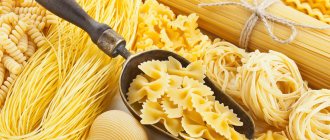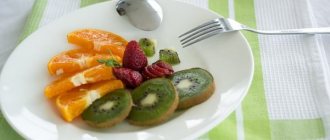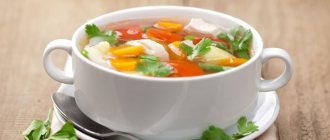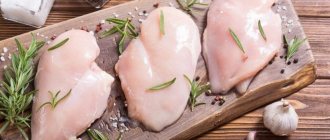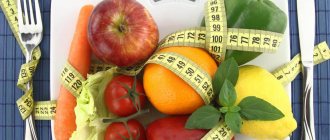In order to have a slim figure and a healthy appearance, you do not need to starve yourself. If you follow a balanced diet, your figure will gradually return to normal.
You can lose weight with pleasure and taste.
Strict diets give quick and short-lived results; they often affect various systems of the body, disrupting their functioning. A balanced diet, on the contrary, improves your health and gives positive results for many years.
The Basics of a Healthy Diet
You need to eat 5-6 times a day in small portions. The main meals are breakfast, lunch and dinner, and an additional 2-3 snacks. The menu must include natural products: fruits, vegetables, honey, fish, legumes, etc. These products contribute to the proper functioning of all organs, and also form a supply of nutrients and vitamins.
The basis of a balanced diet is regular and timely meals.
You should give up bad habits, and also exclude processed foods, fatty and spicy foods, carbonated drinks from your diet, and minimize the consumption of salt, sugar and spices.
Basic principles of a balanced diet
There are many principles with which you can balance your diet. The main ones should be considered.
- You should eat food in small portions and often.
- 20 minutes before your intended meal, you should drink 1 glass of clean water.
- It is not recommended to drink food with food, as this negatively affects the process of digesting food.
- Fatty and fried foods should be excluded from the diet.
- Replace alcoholic drinks with natural juices and purified water.
- You need to eat food at the same time every day, without skipping meals.
- You should avoid snacking on the go.
- It is necessary to perform daily exercises, which will help enhance the effect of a healthy diet.
Knowing what a balanced diet is and its principles, you can develop your own menu for every day.
Energy consumption
Determining energy consumption in each individual case has its own nuances. The energy expended must be compensated by the calories that enter the body with food.
Athletes or those involved in heavy physical work require 4 thousand kcal per day. For those who engage in mental work, this amount is 2.5 thousand kcal. With a decrease in physical activity, calorie consumption decreases sharply.
Age also affects energy expenditure. The older a person is, the fewer calories his body uses. After crossing the milestone of 50 years, the body reduces energy expenditure by 6% every 10 years.
Men's metabolism is 5-10% faster than women's. To replenish energy expenditure, they need to take in more food.
Rule 7. Limit fat content
Fat is essential: Sunflower, olive, corn oils and fish oils contain vitamins and essential fatty acids. However, in the daily diet of a city dweller there is an excess of fat without any useful load.
, but brings it closer to atherosclerosis and coronary heart disease.
Choose foods with a low percentage of fat, replace fried foods with boiled or baked ones, and use non-stick cookware to reduce the amount of fat when cooking. Remember that vegetable oils also contain fat, and limit yourself to a teaspoon of oil per person when dressing your salad.
How to balance your diet. Formula SP
Many people wonder how to balance their diet in order to get the most nutrients from food.
Fats are among the most energy-intensive substances. They contain fatty acids, phospholipids and vitamins. There are animal fats and vegetable fats.
Proteins play the role of foundation. They take part in the synthesis of vitamins, hormones and enzymes.
Carbohydrates are the fuel material that supports all essential functions. Carbohydrates include fiber, which helps digest food.
Vitamins and minerals help the body function properly.
The rules of the joint venture are simple. The volume of protein food entering the body per day is 15%. For every kilogram of a person's weight, there should be 1 g of protein.
The amount of fat entering the body should not exceed 30% of the daily diet. If we translate this into a percentage, we get the following picture:
- up to 10% – saturated acids;
- up to 15% – monounsaturated acids;
- up to 7% – polyunsaturated acids.
Saturated acids are present in large quantities in margarine and butter. Monounsaturated – in oils (corn, sunflower, soybean) and in fish. Polyunsaturated – in olive and peanut oils.
The amount of carbohydrates is 70% of all food consumed per day.
Fiber refers to carbohydrates that are not absorbed by the body. But without it, the normal functioning of the digestive system is disrupted. Foods containing fiber include:
- bread of different types;
- fruits;
- vegetables;
- potato;
- nuts;
- cereals
The joint venture formula will look like this:
DP = 80 g protein + 80 g fat + 400 g carbohydrates.
The daily menu option can be displayed in the table (breakfast, lunch, dinner and 2 snacks):
| Breakfast | The calorie content of breakfast should be no more than 40% of the daily value. |
| Lunch | Should not be more than 100 kcal (proteins, carbohydrates). The best option is cottage cheese with nuts. |
| Dinner | The amount of calories should be 30%. You should eat a hot first course, a side dish of vegetables combined with protein foods, and drink a glass of freshly squeezed juice. |
| Afternoon snack | You can snack on foods containing carbohydrates. Its calorie content should not exceed 150 kcal. It is recommended to drink green tea during the afternoon snack. |
| Dinner | The calorie content of the last meal is 20%. Food should contain vegetable proteins and carbohydrates. |
What is a proper and healthy diet?
Indicators of proper and healthy nutrition are normal weight and good health. A healthy and proper diet is always:
- correspondence of calories consumed to energy consumed;
- providing the body with all necessary macro- and microelements.
A balanced diet does not require large material costs. You can always choose products typical for a given time of year and region at affordable prices.
Important! The amount of fat for any person should not exceed 30% of the daily amount of food.
Be sure to look: Rules and recipes for a menu for healthy eating Rules for compiling and an approximate menu for a week as part of proper nutrition The meaning and rules for drawing up a regime for healthy eating for a healthy person We create a menu for older people correctly: we take into account the characteristics of the body at 60 and 80 years old
Features of SP for women
Developing a balanced diet can be fun. Depending on a woman’s age, different foods should dominate her diet. The main principle of proper nutrition is to eat small portions, but often. The most acceptable option is 6 meals a day. The serving volume should not exceed 250 g.
Every day you need to drink 1.5 liters of pure still water. It is not recommended to eat immediately before bed. Dinner should occur 3 hours before going to bed.
Nutritionists recommend the following “evening” products:
- chicken meat;
- milk;
- porridge;
- mushrooms;
- celery;
- almond;
- apples.
According to recent studies, a high-calorie breakfast not only does not harm your health, but also helps in losing excess weight.
The most healthy and vitamin-rich foods are fruits and vegetables. They must be eaten 400 g per day for the proper functioning of all organs and systems.
Salt and sugar in large quantities are harmful to health. The permissible amount of sugar consumption is 50 g per day (12 tsp). The maximum amount of salt consumed per day is 5 g (1 tsp).
What are functional foods
“Functional foods are those that we can eat, including to solve health problems. For example, as a prevention of certain chronic diseases or even to prevent premature aging. They have special properties and contain nutrients that help maintain health,” explains Rosso. And Elena Soria adds: “Any food or ingredient that goes beyond the function of satiating the body and, for example, also reduces the risk of disease or is generally beneficial to health is functional.”
View on Instagram
Features of SP for men
The balanced nutrition formula for men differs from that for women. The male body requires more calories, because it expends more energy in terms of body weight.
On average, a man needs to drink up to 2 liters of water per day, depending on the individual characteristics of the body.
For heavy physical activity, you need to consume 3500 – 4000 kcal per day. In this case, it is necessary to introduce porridge, rye bread, hard cheese, fish, butter, legumes, etc. into the diet.
Opinions and recommendations of the pros
Nutritionist Viktor Matvienko
The doctor is against strict diets. He sees a return to ideal shape in a balanced diet with sufficient minerals and vitamins. You need to reduce calories and increase activity. And the menu should be dominated by protein and plant foods .
Pierre Dukan. Photo from 24smi.org
Pierre Dukan, famous nutritionist
He believes that in order not to harm your health, you need to lose weight by 4 kilograms per month and no more. And satisfaction in life and in food - two components of health - alone cannot bring success. Pierre Dukan often visits Russia; he is called a “meat nutritionist” because he advises focusing on protein foods. He himself does not eat meat, prefers fish. And he recommends that those who don’t like meat eat fish – it’s also protein.
Lidia Ionova, nutritionist and sports doctor, medical psychologist
Recommends that you create your correct individual diet only in consultation with your doctor. As she says, just because one system helped a friend or colleague does not mean it will help you. The individual characteristics of the body greatly influence the perception of a particular nutritional system. You can’t choose the perfect option for the whole family, look for the best for everyone.
Optimal meal plan
Breakfast is the most important meal of the day and should not be skipped. The calorie content of breakfast should be 400 kcal.
The following products must be selected for the joint venture. The best option is porridge: buckwheat, corn, oatmeal. It is recommended to add berries, fruits, honey and nuts to it.
For lunch, vegetable dishes and side dishes of cereals and hard pasta would be appropriate. Fresh herbs and mushrooms are tasty and healthy.
It is best to have a light vegetable salad and protein foods for dinner. If you really want to eat before bed, you can snack on a small handful of almonds. It is rich in protein and magnesium, helps relax muscles and helps you fall asleep quickly.
Approximate menu for a week
A sample menu for the week would look like this:
- Breakfast dishes:
- porridge with honey or cottage cheese, juice from natural fruits;
- sandwich with low-fat cheese, tea, 1 large orange;
- nuts, casserole (cottage cheese), green tea;
- omelette, shortbread cookies, tea;
- pancakes with curd filling, coffee beans, tangerines.
- Lunch dishes:
- chicken broth with noodles, vegetable salad, baked turkey;
- mushroom soup, vegetable stew, fruit salad, juices;
- buckwheat soup, oatmeal, boiled beef, berry juice;
- vegetable soup, steamed fish, bread (without yeast), compotes;
- beans, boiled meat, vegetable salad, fruit.
- Dishes for dinner:
- seafood salad, cottage cheese casserole with carrots, compote;
- porridge, vegetable salad;
- boiled chicken fillet, Greek salad, green tea;
- vinaigrette seasoned with sunflower oil, baked fish, 100 g of cottage cheese;
- stewed vegetables, jelly.
Menu for the week, budget option
The weekly diet can be displayed in the following table:
| Monday | Z.: 100 g of oatmeal with the addition of 0.5 tsp. honey, applesauce. A: salad of tomatoes, cucumbers and radishes, seasoned with homemade yogurt, 150 g of baked fish. U.: 3 cheesecakes, dried fruit compote. |
| Tuesday | Z.: 1 cup of coffee without additives, a slice of dry bran bread with butter. A: 3 boiled potatoes, sprinkled with dill, dates, tea. U.: vegetable stew, 100 g of stewed cod. |
| Wednesday | Z.: Omelet with tomatoes and bell peppers. A: Brown rice, corn. U.: salad of Chinese cabbage, cucumbers and dill with olive oil. |
| Thursday | Z.: fruit salad with low-fat yogurt. A: broccoli soup, 2 fresh cucumbers, a slice of cheese. U.: cabbage salad with sour cream (15%), 80 g chicken meat. |
| Friday | Z.: black coffee, 1 boiled egg, Chinese cabbage salad. A: 2 boiled potatoes, 3 fresh cucumbers, cheese. U.: 100 g of buckwheat porridge and the same amount of grilled flounder. |
| Saturday | Z.: green tea (unsweetened), vegetable salad. A: 200 g turkey, baked with tomatoes and cheese. U.: 200 g of vegetable stew without salt and spices, carrots and apple in salad for dinner. |
| Sunday | Z.: tea, bread with jam, dried fruits. A: vegetable soup, green bean salad. U.: Noodles with cabbage, omelette. |
Sample menu for a week for losing weight
To lose weight, you need to eat a balanced diet and eat low-calorie foods.
| Reception food Day | Breakfast | Dinner | Dinner |
| Monday | 1 glass of fresh juice or water on an empty stomach, oatmeal with honey and nuts, rye bread. | Fish (steamed or stewed), tea without sugar, boiled potatoes. | Steamed vegetables (starch-free). |
| Tuesday | 100 g low-fat cottage cheese with dried fruits, tea, boiled egg. | Boiled veal, vegetable soup, juice. | Half an avocado, low-fat cottage cheese or kefir. |
| Wednesday | 2 grain breads with cheese, tea with lemon balm, ginger or mint. | 200 g boiled chicken fillet, steamed asparagus, orange juice. | Vegetable salad with rye bread. |
| Thursday | 2 grain breads, low-fat yogurt, juice. | 150 g boiled or baked red fish. | Boiled chicken breast with herbs. |
| Friday | Green tea, 3 slices of low-fat cheese, porridge with dry fruit. | Chicken broth, steamed vegetable sauté. | 150 g fish fillet or cottage cheese. |
| Saturday | 150 g boiled chicken fillet, tea, bread. | Vegetable salad with cheese, mint tea or fresh juice, bread, pasta with tomato paste, | Ryazhenka or drinking yoghurt (unsweetened). |
| Sunday | Porridge with fruit, apples, juice. | 150 g lean meat, steamed cauliflower or broccoli, still water. | Bean salad with red pepper. |
Approximate daily menu for a week to maintain weight at the same level
To keep yourself in good shape, you should do a set of exercises and diet every day. Sample menu:
| Reception food Day | Breakfast | Dinner | Dinner |
| Monday | Tea with cottage cheese and dried fruits. | Buckwheat with lean boiled meat, vegetable salad, whole grain bread. | 3 types of stewed vegetables (your choice). |
| Tuesday | Cheese, porridge with honey and fruit, herbal tea. | Meat broth, steamed fish, yeast-free bread. | Vegetable salad, boiled chicken fillet. |
| Wednesday | Omelet, toast, juice. | Spaghetti with sauce, mushroom soup. | Stewed meat, vinaigrette. |
| Thursday | Cottage cheese, porridge with fruit and milk, tea. | Lasagna, spinach cream soup. | Salmon baked in foil. |
| Friday | Tea, oatmeal with honey and nuts. | Chicken broth, boiled potatoes with herbs. | Sea food salad, bran bread. |
| Saturday | 2 toasts with lean cheese, juice. | Boiled meat with beans. | Vegetable salad with vegetable oil. |
| Sunday | Buckwheat with milk. | Vegetable soup, boiled meat, bread. | Carrot casserole, juice. |
Example of a daily diet
A balanced breakfast plays an important role in a complete diet. Approximate diet:
| Reception food Day | Breakfast | Dinner | Dinner |
| Monday | Millet porridge with raisins. | Lenten cabbage soup. | Salad of cucumbers and tomatoes with herbs and olive oil. |
| Tuesday | Banana smoothie. | Vermicelli soup with breadcrumbs and dill. | Zucchini stewed with pumpkin. |
| Wednesday | Pumpkin, corn porridge. | Spinach soup with beans and broccoli. | Grilled Brussels sprouts. |
| Thursday | Oatmeal with banana. | Buckwheat porridge, broccoli, soy cutlet. | Vegetable okroshka. |
| Friday | Barley porridge with berries. | Pickle with mushrooms. | Brown rice, vegetables, seaweed and seafood salad. |
| Saturday | Oatmeal pancakes. | Steamed cauliflower, red beans, mushrooms. | Vegetable stew. |
| Sunday | Semolina porridge and apple baked with cinnamon. | Pasta with tomatoes, mushrooms, herbs. | Mix of lettuce, tomatoes, green peas with olive oil, soy pate. |
Examples of functional foods
- 1
Dairy products such as milk and yoghurts.
- 2
Milk with additives. As Soria explains, foods with calcium are beneficial for the development of bones and teeth, the nervous system and muscles, and also help prevent osteoporosis. Those enriched with omega-3 help reduce the risk of heart disease, some types of cancer, improve nerve development and visual function, and may also reduce inflammation. There is also milk with vitamins A and , which are necessary for good vision and calcium absorption.
- 3
Fruits, vegetables and herbs.
- 4
Legumes.
- 5
Dark chocolate (due to high cocoa content).
- 6
Whole grains.
- 7
Extra virgin olive oil.
- 8
Olives.
- 9
Nuts and dried fruits.
- 10
Fish.
- 11
Iodized salt. “Foods fortified with iodine help produce thyroid hormones, which are necessary for normal physical and mental development. Our normal diet should already have enough iodine, but there are geographic areas where the water is not iodized, and it is important to supplement the diet with it to avoid thyroid problems,” explains Soria.
View on Instagram
Balanced menu for the week
You can create your own menu for each day. It is recommended to consult a nutritionist about drawing up a joint venture menu for different periods.
Menu for children
SB for children must contain all the substances necessary for growth and development: fruits, vegetables, berries, meat, fish, grains and legumes. It is not recommended to give children store-bought sweets, chips, corn sticks, carbonated drinks, etc.
The daily requirement of a child’s body for vitamins and microelements is expressed in the table.
| 3 years | 4-6 years | 7 years | |
| Energy value, kcal | 1540 | 1970 | 2350 |
| Proteins, g | 53 | 68 | 77 |
| Fats, g | 53 | 68 | 79 |
| Carbohydrates, g | 212 | 272 | 335 |
Menu for women
There are various formulas for individual calculation of the required number of calories per day. They take into account a person’s personal parameters. For a woman, the daily calorie intake is 1800-2000.
To create a weekly menu for a woman, you should consult a nutritionist who will take into account the individual characteristics of the body: age, health status, metabolism, etc.
To maintain healthy functioning of the body, it is necessary to consume the following elements:
• amino acids (animal proteins – meat, milk, eggs);
• Omega-3 unsaturated fatty acids (spinach, fish, flaxseed oil);
• long carbohydrates (oatmeal, buckwheat, legumes, rice).
You should not suddenly switch to a new diet, because this is not a rigid diet, and radical measures will be unnecessary. The calorie content of foods should be reduced slowly so as not to put the body into a stressful state. Food should bring not only benefits, but also pleasure.
Menu for men
For an office worker who is not overweight, who does not go to the gym, but spends time actively on weekends, the daily norm will be 3000 kcal.
Approximate men's menu for 1 day:
1. Breakfast: scrambled eggs with bacon or chicken sausage salad with boiled eggs and fresh cucumber, seasoned with sour cream (fat content no more than 15%). You can drink a cup of black (green) tea or coffee with milk (cream should be excluded from the diet). Toast with honey (jam) or a black bread sandwich with caviar or salmon will go well with tea.
2. Lunch: meat broth with vegetables or chicken noodle soup. For the second course - puree with boiled lean meat (the best option is 200 g of chicken fillet). Tea with a sandwich or toast.
3. Dinner: vegetable stew or stewed cabbage with meat. You can replace them with 3 pancakes with meat filling. 2 hours before going to bed, you should eat low-fat cottage cheese, and before going to bed, drink 1 glass of kefir or yogurt.
Between main meals, you can have snacks (if necessary), during which it is recommended to eat a fruit or vegetable salad and a sandwich with tea.
Menu for the whole family
Creating a menu for a family is not an easy task, since it is necessary to take into account the needs and individual characteristics of each member. Before starting to create a menu, you should consult a nutritionist.
Menu for schoolchildren
When entering school, the load on the body, in particular on the brain and nervous system, increases many times over. Children definitely need to have breakfast. For breakfast, it is good to eat muesli or chocolate balls with milk. You must take cheese sandwiches, fruit, and water with you to school. First courses are the basis of the diet for a growing body. There should be light snacks between main meals.
For athletes
The sports menu is selected depending on the level of stress, type of sport, and physical characteristics of the athlete. His diet should contain 30% proteins, 10% fats, 60% carbohydrates. Products for sporty people:
- poultry meat;
- cottage cheese;
- eggs;
- oil;
- nuts;
- bread;
- cereal porridges;
- fruits and vegetables.
For the vegan bodybuilder
The nutritional program of a vegan bodybuilder can be varied. The most suitable products for this lifestyle:
- soy;
- Soy meat;
- tofu;
- chickpeas;
- lentils;
- peas;
- seitan;
- nuts, cereals, legumes, fruits;
- rice (red, brown, black);
- buckwheat;
- durum pasta;
- oat groats;
- dates, raisins, prunes, dried apricots;
- avocado;
- citrus;
- rose hip.

